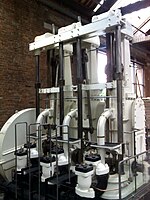Affinity Living Riverview
2021 establishments in EnglandApartment buildings in EnglandBuildings and structures in SalfordGreater Manchester building and structure stubsResidential buildings completed in 2021 ... and 1 more
Use British English from March 2023

Affinity Living Riverview is a 110 m (360 ft) tall, 35-storey residential high-rise building in Salford, Greater Manchester, England. It is located on the north bank of the River Irwell, near to Manchester's key central business district of Spinningfields. The building was designed by Denton Corker Marshall, the architects behind the nearby Civil Justice Centre. As of 2023, it is the third-tallest building in Salford and the 13th-tallest building in Greater Manchester.
Excerpt from the Wikipedia article Affinity Living Riverview (License: CC BY-SA 3.0, Authors, Images).Affinity Living Riverview
Quay Street, Salford City Centre
Geographical coordinates (GPS) Address Nearby Places Show on map
Geographical coordinates (GPS)
| Latitude | Longitude |
|---|---|
| N 53.4825 ° | E -2.25196 ° |
Address
Affinity Living Riverside
Quay Street 32
M3 5AP Salford, City Centre
England, United Kingdom
Open on Google Maps










